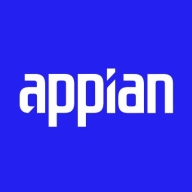

OpenText 360 for SharePoint and Appian are competitors in the document management and process automation markets. OpenText has an advantage with its strong integration with Microsoft Teams and document management capabilities, whereas Appian stands out for its rapid application development and low-code capabilities, making it better suited for diverse business requirements.
Features: OpenText 360 for SharePoint provides seamless integration with Microsoft Teams, offers robust document management with version control, and facilitates automation through Power Automate. Appian features a low-code platform for rapid application development, strong process modeling capabilities, and flexible integration with various enterprise tools.
Room for Improvement: OpenText 360 needs to enhance its handling of large document volumes, simplify its licensing structure, and improve integration with Microsoft Office 365. Appian should focus on improving UI customization, expanding offline capabilities, and enhancing scalability for larger workloads.
Ease of Deployment and Customer Service: OpenText 360 offers various deployment models, but technical support varies by region. Appian provides adaptable deployment options and generally good technical support, albeit complex for advanced issues.
Pricing and ROI: OpenText 360's complex licensing model can be expensive, yet it offers strong ROI in document management. Appian, while also costly, offers flexible pricing models and high ROI through rapid application deployment capabilities, with pricing more competitive compared to peers like Pega.
Appian is very efficient, allowing us to build a lot of applications within a financial year, making it cost-effective.
It eliminates the challenges associated with handling files on local servers and allows efficient document management.
Their customer service is responsive, and the team is very prompt for support.
The technical support is generally good.
Appian has a community where I can put my questions.
I have not directly contacted vendor support but use forums for any queries or issues while utilizing OpenText 360 for SharePoint.
Appian is scalable, but it depends on how you build your applications.
Initially, without much coding, I can easily handle five thousand records.
It depends on how it has been designed and how it has been configured.
I would like to see more enhancement in the user interface to allow more freedom in designing the sites and pages.
If there is a very complex process that includes a lot of data transitioning and memory-centric processes, it consumes a lot of memory.
Integration with a feature like Planner could assist in assigning tasks to specific individuals for follow-up.
The GUI should be improved for better user experience.
On the pricier side, both Appian and Pega are enterprise-level solutions, placing them on the slightly higher side.
The pricing of Appian is based on the number of users and generally ranges from 70 to 100 USD per user per month.
Pricing is very affordable as it is part of the Office 365 suite, costing around five dollars per user.
In terms of pricing, OpenText 360 for SharePoint is more expensive than Microsoft.
The zero-code integration feature is remarkable, allowing for ease of data transfer and workflow enhancement.
It is easy for me to define the process and create configurable workflows.
I can create tables, perform database-related activities, and create multiple tables.
OpenText 360 for SharePoint significantly saves time for users by streamlining the tasks of handling, searching, and maintaining documents compared to traditional file servers.
It offers automation capabilities with Power Automate, enabling automation of invoicing with API support from SAP.


Appian is a unified low-code platform and solution used by businesses to build enterprise applications and workflows. This product adapts to the needs of clients and the technologies they are already using to combine their data in a single workflow and maximize resources. The platform has four main components through which it transforms the work process for companies of various sizes. They are:
Appian is utilized across a diverse set of industries, including automotive and manufacturing, energy and utilities, education, financial services, telecom and media, transportation, retail, insurance, healthcare, and life sciences. The most frequent use cases of Appian are customer journey, governance, risk and compliance, operational efficiency, supply chain, distributed order management, and environmental, social, and governance (ESG) management.
Appian Features
Appian has various features that allow users to create solutions for their businesses. These features can be separated into a few groups according to function, including automation, low-code application development, and integrations and data. Some of the most frequently used features of Appian include:
Appian Benefits
The benefits of using Appian include:
Reviews from Real Users
A practice leader - digital process automation at a computer software company values Appian highly because the product is easy to develop, low-code, and has a good user interface.
Alan G., an advisory board member at Codecon VR, Appian offers a clear application life cycle, easy to learn documentation, and comes with a fundamentals course.
We monitor all Business Process Management (BPM) reviews to prevent fraudulent reviews and keep review quality high. We do not post reviews by company employees or direct competitors. We validate each review for authenticity via cross-reference with LinkedIn, and personal follow-up with the reviewer when necessary.